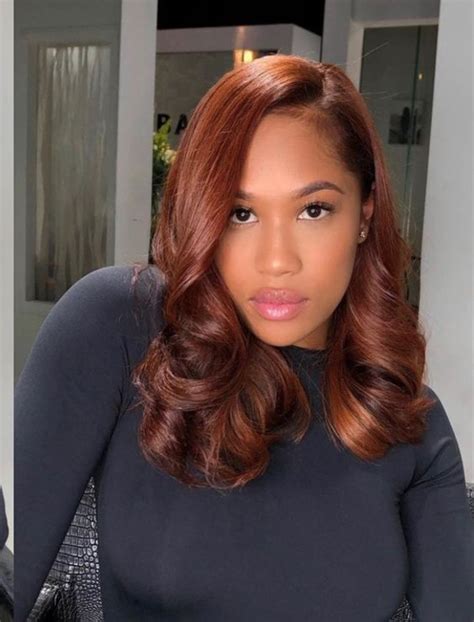Embracing the Power of Expression
For centuries, black women have adorned their hair with an array of colors, textures, and styles. Inspired by the vibrant and expressive world of cinema, these vibrant hues have become a staple of beauty and self-expression. From the fiery reds of classic Hollywood icons to the ethereal blues of contemporary sci-fi films, the possibilities are endless.

Pain Points:
- Limited access to hair color options tailored to black hair.
- Fear of damaging hair during color treatments.
- Difficulty finding inspiration for hair colors that complement black skin tones.
Motivations:
- Desire to express oneself through unique and eye-catching hair colors.
- Inspiration from iconic film characters and the enchantment of cinema.
- Exploration of hair colors that flatter black skin tones and bring out its natural beauty.
Hues of History: Cinema’s Influence on Hair Colors
The allure of film-inspired hair colors transcends time, with each era bringing forth its own iconic shades.
The Golden Age of Hollywood
The silver screen of classic Hollywood introduced the world to glamorous actresses like Dorothy Dandridge and Lena Horne, whose vibrant red hair became synonymous with beauty and sophistication. These bold hues added a touch of allure to their characters and left an indelible mark on the minds of viewers.
The Blaxploitation Era
The 1970s witnessed the rise of the Blaxploitation era, where black films showcased the lives and struggles of African Americans. Actresses like Pam Grier and Tamara Dobson embraced fiery orange, yellow, and platinum blonde hair that symbolized strength and empowerment.
Modern Cinema
In recent years, the diversity of black women in film has exploded, bringing forth a plethora of hair color inspiration. From the ethereal blues of Amandla Stenberg in “The Hunger Games” to the vibrant greens of Lupita Nyong’o in “Black Panther,” film characters have showcased the versatility and beauty of hair colors on black skin.
A Spectrum of Shades: Colors for Every Complexion
Finding the right hair color to complement black skin requires consideration of undertones and complexion.
Cool Undertones:
- Darkest brown and deepest black skin tones look stunning with shades of blue, purple, and green.
- Avoid colors with warm undertones, such as orange or yellow.
Warm Undertones:
- Lighter brown and olive skin tones are flattered by shades of red, orange, and gold.
- Avoid colors with cool undertones, such as blue or purple.
Neutral Undertones:
- Versatile skin tones can experiment with a wide range of colors, both warm and cool.
Flawless Film-Inspired Hues: A Step-by-Step Guide
Achieving film-worthy hair colors requires careful planning and execution.
Step 1: Determine Your Undertones
- Analyze your skin’s veins: Cool undertones have bluish-purple veins, while warm undertones have greenish-yellow veins. Neutral undertones have a mix of both.
- Observe your jewelry preferences: Silver and white metals complement cool undertones, while gold and copper complement warm undertones.
Step 2: Choose a Salon or Colorist
- Seek a professional who specializes in working with black hair and understands the complexities of color treatments.
- Consult with your colorist to determine the best hair color and technique for your desired look.
Step 3: Protect Your Hair
- Use a deep conditioning treatment before and after coloring to minimize damage.
- Avoid heat styling and harsh chemicals that can weaken the hair.
Step 4: Color and Care
- Ensure the colorist uses quality products and techniques to maintain the integrity of your hair.
- Follow the care instructions provided by your colorist to preserve your hair’s health and vibrancy.
Tips and Tricks: Enhancing Your Film-Inspired Hues
- Consider a color-depositing conditioner to maintain the vibrancy of your hair color between salon visits.
- Experiment with hair accessories, such as headbands or scarves, to add a touch of flair to your style.
- Protect your hair from sun damage by wearing a protective hat or scarf when outdoors.
- Avoid swimming in chlorinated water, as it can fade hair colors.
Table 1: Undertones and Complementary Hair Colors
| Undertones | Complementary Hair Colors |
|---|---|
| Cool | Blue, purple, green |
| Warm | Red, orange, gold |
| Neutral | Both warm and cool colors |
Table 2: Film-Inspired Hair Colors for Different Skin Tones
| Skin Tone | Complementary Hair Colors |
|---|---|
| Deepest Black | Blue-black, purple-black |
| Deep Black | Burgundy, dark red, deep purple |
| Dark Brown | Mahogany, chocolate brown, amber |
| Light Brown | Auburn, caramel, honey blonde |
| Olive | Golden blonde, strawberry blonde, copper |
Table 3: Celebrity Hair Inspiration for Film-Inspired Hues
| Celebrity | Film | Hair Color |
|---|---|---|
| Amandla Stenberg | The Hunger Games | Ethereal blue |
| Lupita Nyong’o | Black Panther | Vibrant green |
| Kerry Washington | Scandal | Fiery red |
| Halle Berry | X-Men | Platinum blonde |
| Viola Davis | The Woman King | Deep purple |
Table 4: Hair Color Maintenance Tips
| Tips | Benefits |
|---|---|
| Deep conditioning treatments | Restore moisture and protect hair from damage |
| Color-depositing conditioners | Refresh hair color between salon visits |
| Sun protection | Prevent color fading |
| Avoid chlorine | Protect hair from fading |
| Professional styling | Ensure proper color application and hair care |
Embracing Your Film-Inspired Transformation
Hair colors inspired by cinema offer a boundless realm of expression and self-discovery. By embracing the hues that resonate with you, you can embody the power of film characters and create a style that is uniquely yours. Remember, the journey to your desired hair color should be an empowering and enjoyable one.
